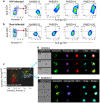Polyreactive antibodies plus complement enhance the phagocytosis of cells made apoptotic by UV-light or HIV
- PMID: 23881356
- PMCID: PMC3721073
- DOI: 10.1038/srep02271
Polyreactive antibodies plus complement enhance the phagocytosis of cells made apoptotic by UV-light or HIV
Abstract
Polyreactive antibodies are a major component of the natural antibody repertoire and are capable of binding a variety of structurally unrelated antigens. Many of the properties attributed to natural antibodies, in fact, are turning out to be due to polyreactive antibodies. In humans, each day, billions of cells undergo apoptosis. In the present experiments, we show by ImageStream technology that although polyreactive antibodies do not bind to live T cells they bind to both the plasma membrane and cytoplasm of late apoptotic cells, fix complement, generate the anaphylatoxin C5a and increase by as much as 5 fold complement-mediated phagocytosis by macrophages. Of particular importance, T cells undergoing apoptosis following infection with HIV also bind polyreactive antibodies and are phagocytosed. We conclude that the polyreactive antibodies in the natural antibody repertoire contribute in a major way to the clearance of cells made apoptotic by a variety of natural and infectious processes.
Conflict of interest statement
The authors declare no competing financial interests.
Figures







References
-
- Tauber, A. I. & Podolsky, S. H. The Generation of Diversity: Clonal Selection Theory and the Rise of Molecular Immunology, (Harvard University Press, Cambridge, MA, 1997).
-
- Satoh J, Prabhakar BS, Haspel MV, Ginsberg-Fellner F, Notkins AL. Human monoclonal autoantibodies that react with multiple endocrine organs. N Engl J Med. 1983;309:217–220. - PubMed
-
- Casali P, Notkins AL. Probing the human B-cell repertoire with EBV: polyreactive antibodies and CD5+ B lymphocytes. Annu Rev Immunol. 1989;7:513–535. - PubMed
-
- Coutinho A, Kazatchkine MD, Avrameas S. Natural autoantibodies. Curr Opin Immunol. 1995;7:812–818. - PubMed
-
- Notkins AL. Polyreactivity of antibody molecules. Trends Immunol. 2004;25:174–179. - PubMed
Publication types
MeSH terms
Substances
Grants and funding
LinkOut - more resources
Full Text Sources
Other Literature Sources

